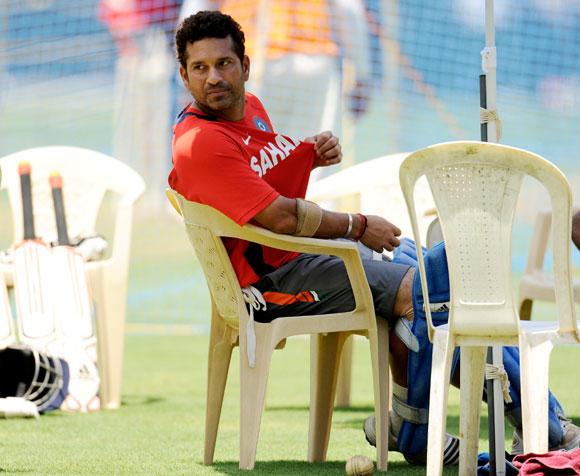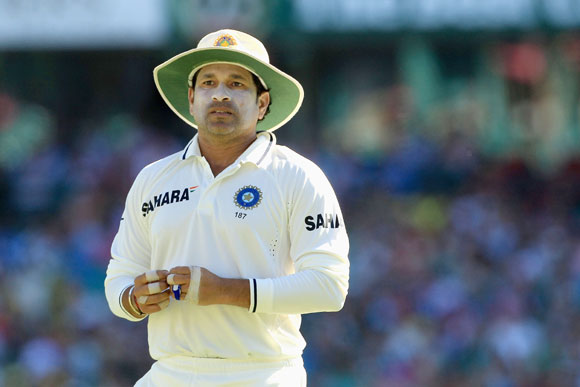 | « Back to article | Print this article |
Tendulkar @ the Wankhede: Good, but not quite effective
Sachin Tendulkar's dual failure in the second Test against England prompts Bikash Mohapatra to dig out his record at his home ground.
When Sachin Tendulkar last played in a Test match at the Wankhede stadium, against West Indies in November last year, there was a sense of anticipation.
Fans were eager to see the Master Blaster score that elusive 100th hundred on his home ground. The batsman did keep them excited for a couple of days, with ticket sales going up -- a strange occurrence as far as Test cricket is concerned in India -- before eventually leaving them disappointed (He was out for 94).
A year later, when Tendulkar played in a Test at the Wankhede, there was no expectation whatsoever. The batsman has had a slump in form for a considerable period now and even his staunchest supporters had come to term with the fact that his best days were behind him.
The fact that he scored eight in each innings didn't cause as much rancor as did India's shoddy performance in what was a terribly disappointing defeat.
Wankhede ranks well below in the list
Tendulkar's dual failure -- his match aggregate of 16 saw his Test average at the venue fall to an all-time low, from a high of 86.25 in 1997 -- also reiterated the fact that he hasn't been as effective playing on his home ground.
Before the many Tendulkar fans take umbrage to the above statement, it is imperative here to mention that statistics don't exactly give an accurate picture in this case -- the 39-year-old aggregates a handsome 847 runs in his 10 Tests (@ 47.06) at the Wankhede, including a century and seven fifties.
If one takes into account only the number of runs scored, Tendulkar has more or less equaled contemporary Brian Lara's record -- 986 runs in 12 Tests (@42.87) at Queen's Park Oval -- on his home turf and definitely done much better than compatriots Sourav Ganguly -- 440 runs in eight Tests (@31.43) at the Eden Gardens -- and Rahul Dravid -- 304 runs in eight Tests (@ 21.71) at the Chinnaswamy stadium.
But numbers don't tell the true story.
Among the venues where Tendulkar has appeared in most Tests matches (see box), the Wankhede ranks way below in the list.
Tendulkar hasn't made an impact on home soil
What also cannot be denied is the fact that most of his knocks at the Wankhede either failed to have the desired impact or were trumped by another player's performance.
For instance, his lone hundred - only one of his 51 Test hundreds have come on his home ground - at the venue -- 148 against Sri Lanka in December 1997 -- was eclipsed by a majestic 173 from man-of-the-match Ganguly, even as the Test ended in a draw.
Similarly, his only man-of-the-match winning effort -- 97 against South Africa in February 2000 -- came in what was a lost cause.
Also, in the only instance he delivered in both the innings at the venue -- 76 and 65 against Australia in 2001 -- he could not help his team avoid defeat.
The Wankhede crowd booed him in 2006
And who can forget that infamous episode of March 2006?
It was the third and final Test against England, one where Tendulkar became the most capped Indian player in history -- playing his 132nd Test (surpassing Kapil Dev's tally of 131).
Coming into the match woefully short of confidence -- having scored just 112 runs in the six previous Tests (@18.66), Tendulkar played 21 balls to score a painstaking single.
Even as he walked back, having edged a James Anderson delivery to Geraint Jones behind the stumps, the unimaginable happened.
The crowd at the Wankhede booed the player they always eulogized. Something incomprehensible till then had actually happened.
Against England, Tendulkar failed in both innings
While his dual failure against England on this occasion evoked no reaction, and predictably so, question marks do remain whether this was his last Test at the Wankhede.
Though many were of the view that this was his last Test on his home ground, the Master Blaster refrained from making any announcement.
The fact that his performance has gone from bad to worse on his home ground, and way past his best in general, means even if he does play at the Wankhede in future it would elicit anything but excitement from the home fans.
Tendulkar perhaps still awaits the perfect homecoming. The problem is, he doesn't have time on his side.




